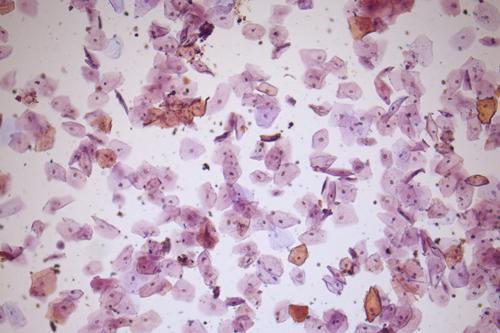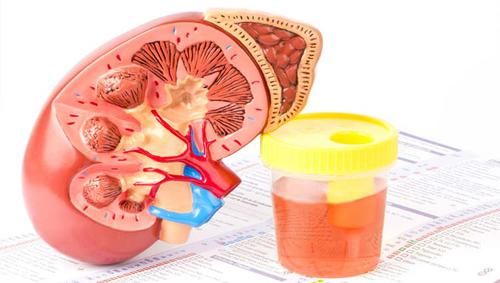Why the Epithelial Cells Appear in Urine?
All of the surfaces of the human body, whether internal or external, are covered by epithelial cells, including the skin, organs, and blood vessels, as well as the urinary tract. These cells protect the body from various pathogenic agents, especially viruses. The urine of a healthy person contains a certain number of epithelial cells. Any increase in their number indicates a pathological process in the body, including various infections or kidney disease.
Based on differences in shape, size, appearance, and origin, it is possible to define three types of epithelial cells in urine. The most important ones are renal tubular cells (renal cells), which are an indicator of kidney health. The largest type, squamous cells, comes from the urethra and vagina. Their number is higher in women's urine. The third type, transitional cells (bladder cells), is typical for the urethra and renal pelvis of older men.
Causes of an Increased Amount of Epithelial Cells in Urine
There are various general causes of high counts of epithelial cells in urine, such as a weakened immune system, an enlarged prostate, or high blood pressure, but the most common are:
1. UTI (urinary tract infections)
Bacteria cause most urinary tract infections, but in some cases, the causative agents can be fungi and viruses. Although the disease is most common in the lower parts of the urinary tract (urethra and bladder), ureters and kidneys also may be affected. Women are prone to UTIs because of shorter urethras, but general symptoms of infections are similar regardless of sex. They include an intense urge to urinate, a burning feeling while urinating, fever, pain in the back or lower abdomen, and dark and smelly urine.
2. CKD (chronic kidney disease)
It is a standard, long-term condition usually related to age and more common in people of African and Asian descent. But, anyone's kidneys can stop working properly, regardless of age or ancestry. In the early stages, there are no obvious characteristic symptoms except positive results of blood or urine tests (tests show the presence of epithelial cells and blood in urine). In the advanced stages, symptoms such as swollen ankles and hands, tiredness, shortness of breath, nausea, vomiting, loss of appetite, and high blood pressure will appear.
3. Kidney stones (nephrolithiasis)
These are created by the deposition of dissolved minerals and salts on the inner lining of the kidneys. There are four types: calcium stones, struvite stones, uric acid stones, and cystine stones. The primary causes are from highly concentrated urine due to dehydration or a genetic predisposition. Although kidney stones cause pain, if discovered in time, they won't cause permanent damage. The most common symptoms are cloudy and smelly urine, a fluctuating severe pain in the back and below the ribs, painful urination, fever and chills, and persistent urination of small amounts of urine. Tests will show excess blood and epithelial cells in the urine.

4. Diabetes mellitus
This disease involves a problem with insulin (the pancreatic hormone). Insulin's regular function is to help the body use and store sugar from food. When the pancreas can't produce an adequate amount of insulin for some reason, the body is unable to use glucose (blood sugar) properly. There are two types of diabetes (type 1 and type 2), with symptoms including frequent urination, increased thirst, weight loss, extreme hunger, low resistance to infections, and slow-healing sores. Tests will show excess epithelial cells and ketones in urine.
Treatments for the Most Common Causes
1. For urinary tract infection
The first line of treatment for URI (urinary tract infection) is an adequate dose of antibiotics over an extended period to prevent repeat infections. A doctor will determine the specific antibiotic and length of treatment after considering the type of bacteria found in urine and the health condition of the patient. The most commonly recommended drugs for uncomplicated UTI include Fosfomycin, Ceftriaxone, and Cephalexin. Usually, symptoms disappear after just a few days of treatment, but that doesn't mean that it is okay to stop the antibiotic treatment immediately! All prescribed medicines should be taken until fully used.
2. For kidney disease
Kidney disease tends to be progressive and may cause permanent damage. This disease is entirely treatable if caught in the early stages. However, when it becomes chronic, there is no particular medicine. Symptomatic therapies include lifestyle changes, controlling the level of cholesterol and blood pressure, statin drugs to lower cholesterol levels, supplements to treat anemia, diuretics to relieve swelling, and calcium to protect bones. The final treatment option is dialysis, which can partially replicate the kidney function.
3. For diabetes
Diabetes is a severe disease, and only a doctor can prescribe an adequate therapy for each particular case. There is still no ultimate cure for this condition, but healthy eating, physical activity, daily monitoring of the blood sugar level, carbohydrate counting, insulin pumps, diabetes medications, and insulin injections can help.

Preventions for Related Disease
Until the antibiotic treatment takes effect, changing the lifestyle and some home remedies can ease discomfort. Drinking plenty of water will dilute urine and help to flush out bacteria, but coffee, soft drinks, and alcohol are not recommended. In alternative medicine, cranberry juice is a very popular prevention of UTI. Physicians may advise cutting back on salt and foods high in cholesterol, as well as increasing physical activity. In some cases, applying a warm heating pad to the abdomen will decrease bladder pressure and relief of symptoms.
Summary
Epithelial cells line the surfaces of the body, organs, and blood vessels. Results of a standard urine test will always show epithelial cells in urine normal range because a healthy person typically has a small number of them in their urine. Every increase in the presence of these cells indicates possible infection, the kidney stones, or kidney disease.
YOU MAY LIKE
-
Amazing Facts About Pain in the Back and Frequent Urges to Urinate
-
Why Does It Hurt When I Pee
-
Why Do You Pee When You Cough?
-
6 Effective Ways to Treat Urinary Tract Infection (UTI)
-
Ways to Avoiding Urinary Tract Infections
-
Vital Tips to Prevent Kidney Stones
-
Best Ways to Get Rid of Kidney Stones
-
Abdominal Pain and Frequent Urination Female: Causes and Tips
-
Want to Pee but Can’t? Reasons and Solutions Why This Could Happen
-
Causes and Tips for White Blood Cells in Urine
